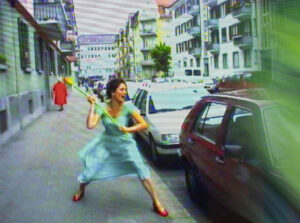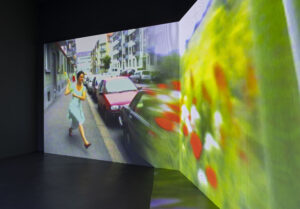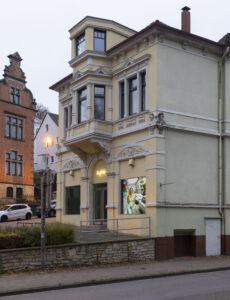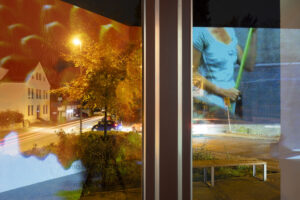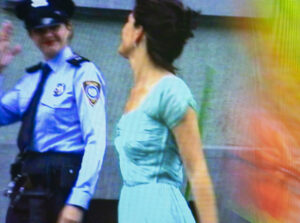17.23
Pipilotti Rist Ever Is Over All
Ever Is Over All
More
Rist’s pieces often include explicit depictions of female bodies (or body parts) and sexuality, albeit with an ambivalent, humorous tone (Pickelporno / Pimple porno, 1992; Homo Sapiens Sapiens, 2005). Other important themes include her personal identity as an artist and the potential for failure that comes with it. ((Entlastungen) Pipilottis Fehler / (Absolutions) Pipilotti’s mistakes, 1988; Pepperminta, 2009).
The artist’s initial videos featuring herself in front of the camera were created in the late 1980s. Using a mix of blurred image interference, background noise, and self-referential text, Rist pays homage to the early days of experimental film and video art while also revealing the manipulative possibilities inherent in image and video production at the time. The video installation seen here, titled Ever Is Over All, was created for the 47th Venice Biennale in 1997 and garnered the artist international acclaim. Rist’s subsequent work illustrates the amalgamation of her distinct visual idiom with magnified depictions of nature and everyday life, fragmented body images, and intricate musical compositions. The artist’s work found a wider audience with her presentation of the video Open My Glade (2000) in New York City’s Times Square (2000/17). No less spectacular was Homo Sapiens Sapiens (2005), a video work specially designed as a ceiling projection that was prematurely closed at the 51st Venice Biennale due to its provocative nature. Rist premiered her first feature film, Pepperminta, at the Venice International Film Festival in 2009. The artist also designs site-specific environments for her exhibitions, providing audiences with immersive experiences that encourage deep engagement with her work.
Ever Is Over All consists of two overlapping projections. On the left, a single continuous shot shows a girlishly dressed young woman in a blue dress, red shoes, and red lipstick. She walks along a sidewalk lined with houses and parked cars, happily carrying an oversized flower. At the same time, on the other screen, nature footage shows a lush, blooming meadow dotted with exotic flora. Both videos appear deliberately slowed down, almost in slow motion. The enchanting, evocative visual narrative in both scenes takes a sudden and unexpected turn when the woman holding the long-stemmed umbel violently smashes a row of car windows. The meditative music abruptly gives way to the shattering sound of breaking glass. This pivotal moment, a moment of shock, is repeated several times. A passing policewoman and a pedestrian in a red coat give non-verbal nods of approval as the act unfolds in public space. The video ends as casually and harmlessly as it began.
With remarkable lightness and ease, the artist creates contradictory moments that reveal not only her own understanding of her role, but her expectations as well.
From a distance, we assume the role of silent witnesses to an unconventional act, complicit in the unfolding process. The artist skillfully subverts gendered traits such as aggression and weapon violence by assigning them to the seemingly girlish protagonist, who openly expresses these attributes. Adding to the contrast is the chosen weapon itself—a phallus-like umbel capable of shattering car windows (patriarchy), to name just one of many interpretations. Rist’s work effectively transforms destructive energy into hope, presenting a feminist plea for greater empowerment and freedom. Its persuasiveness lies in its playful and subversive aesthetic, which emphasizes the transformative nature of its message.
Ever Is Over All can be interpreted not only within the framework of current discourses, but also as an integral part of a critical practice of feminist media art. Specifically, artists within the feminist avant-garde¹ explore how conventional representations of women contribute to and determine the formation of female stereotypes and identities in our society. They probe the supposed dichotomy between domestic and artistic labor, production and reproduction; they also reflect on the role of women in a professional and media landscape heavily influenced by male stereotypes. Another focus is the exploration of female sexuality, the body, societal standards of beauty, and violence against women. These issues and themes continue to define the social reality for many women today and remain central to artistic practices that seek to illuminate and challenge deeply entrenched norms.
Pipilotti Rist’s work remains as relevant as ever in 2023, addressing as it does the ongoing issue of unequal gender relations by offering a timeless interpretation firmly grounded in the contemporary context. A multifaceted example of feminist video art, the artist’s work dismantles conventional viewpoints and challenges established gender dynamics while embracing video as a powerful medium for self-empowerment.
Pipilotti Rist, born in 1962 in Rheintal (CH), lives and works in Zurich (CH). She studied at the University of Applied Arts in Vienna and first learned video production through specialized training at the Schule für Gestaltung in Basel. She has been active in performance and pop music since 1984 and was a co-founder of the female pop band and performance group Les Reines prochaines (1988–1994). In 1988, she shifted her artistic focus to video/film and video installations. Her body of work since the 2000s has also included environments, photomontages, art-in-architecture and public works, including those in Berlin, Buchs, St. Gallen, Geneva, and Zurich. Recent solo exhibitions (selection) include presentations at the Museum of Fine Arts Houston (US, 2023); M+, Kowloon, Hong Kong (HK, 2023); the Bechtler Stiftung, Uster (CH, 2022); the National Museum of Qatar, Doha (QA, 2022); the Depot Boijmans Van Beuningen, Rotterdam (NL, 2021); the National Museum of Modern Art, Kyoto (JP, 2021); the Museum of Contemporary Art, Los Angeles (US, 2021); and Vleeshal, Middelburg (NL, 2020). Her works have also featured in numerous biennials, group exhibitions, and festivals, including those at the Pinakothek der Moderne, Munich (2023); the Julia Stoschek Foundation, Düsseldorf (2023); Kunsthalle Mannheim (2023); Fundació Joan Miró, Barcelona (ES, 2023); Kunstmuseum Basel (CH, 2022); the Museum of Contemporary Art Antwerp (BE, 2022); ARKEN Museum for Modern Art, Skovvej (DK, 2022), and Kunstmuseum Wolfsburg (2022).
The artist’s initial videos featuring herself in front of the camera were created in the late 1980s. Using a mix of blurred image interference, background noise, and self-referential text, Rist pays homage to the early days of experimental film and video art while also revealing the manipulative possibilities inherent in image and video production at the time. The video installation seen here, titled Ever Is Over All, was created for the 47th Venice Biennale in 1997 and garnered the artist international acclaim. Rist’s subsequent work illustrates the amalgamation of her distinct visual idiom with magnified depictions of nature and everyday life, fragmented body images, and intricate musical compositions. The artist’s work found a wider audience with her presentation of the video Open My Glade (2000) in New York City’s Times Square (2000/17). No less spectacular was Homo Sapiens Sapiens (2005), a video work specially designed as a ceiling projection that was prematurely closed at the 51st Venice Biennale due to its provocative nature. Rist premiered her first feature film, Pepperminta, at the Venice International Film Festival in 2009. The artist also designs site-specific environments for her exhibitions, providing audiences with immersive experiences that encourage deep engagement with her work.
Ever Is Over All consists of two overlapping projections. On the left, a single continuous shot shows a girlishly dressed young woman in a blue dress, red shoes, and red lipstick. She walks along a sidewalk lined with houses and parked cars, happily carrying an oversized flower. At the same time, on the other screen, nature footage shows a lush, blooming meadow dotted with exotic flora. Both videos appear deliberately slowed down, almost in slow motion. The enchanting, evocative visual narrative in both scenes takes a sudden and unexpected turn when the woman holding the long-stemmed umbel violently smashes a row of car windows. The meditative music abruptly gives way to the shattering sound of breaking glass. This pivotal moment, a moment of shock, is repeated several times. A passing policewoman and a pedestrian in a red coat give non-verbal nods of approval as the act unfolds in public space. The video ends as casually and harmlessly as it began.
With remarkable lightness and ease, the artist creates contradictory moments that reveal not only her own understanding of her role, but her expectations as well.
From a distance, we assume the role of silent witnesses to an unconventional act, complicit in the unfolding process. The artist skillfully subverts gendered traits such as aggression and weapon violence by assigning them to the seemingly girlish protagonist, who openly expresses these attributes. Adding to the contrast is the chosen weapon itself—a phallus-like umbel capable of shattering car windows (patriarchy), to name just one of many interpretations. Rist’s work effectively transforms destructive energy into hope, presenting a feminist plea for greater empowerment and freedom. Its persuasiveness lies in its playful and subversive aesthetic, which emphasizes the transformative nature of its message.
Ever Is Over All can be interpreted not only within the framework of current discourses, but also as an integral part of a critical practice of feminist media art. Specifically, artists within the feminist avant-garde¹ explore how conventional representations of women contribute to and determine the formation of female stereotypes and identities in our society. They probe the supposed dichotomy between domestic and artistic labor, production and reproduction; they also reflect on the role of women in a professional and media landscape heavily influenced by male stereotypes. Another focus is the exploration of female sexuality, the body, societal standards of beauty, and violence against women. These issues and themes continue to define the social reality for many women today and remain central to artistic practices that seek to illuminate and challenge deeply entrenched norms.
Pipilotti Rist’s work remains as relevant as ever in 2023, addressing as it does the ongoing issue of unequal gender relations by offering a timeless interpretation firmly grounded in the contemporary context. A multifaceted example of feminist video art, the artist’s work dismantles conventional viewpoints and challenges established gender dynamics while embracing video as a powerful medium for self-empowerment.
Pipilotti Rist, born in 1962 in Rheintal (CH), lives and works in Zurich (CH). She studied at the University of Applied Arts in Vienna and first learned video production through specialized training at the Schule für Gestaltung in Basel. She has been active in performance and pop music since 1984 and was a co-founder of the female pop band and performance group Les Reines prochaines (1988–1994). In 1988, she shifted her artistic focus to video/film and video installations. Her body of work since the 2000s has also included environments, photomontages, art-in-architecture and public works, including those in Berlin, Buchs, St. Gallen, Geneva, and Zurich. Recent solo exhibitions (selection) include presentations at the Museum of Fine Arts Houston (US, 2023); M+, Kowloon, Hong Kong (HK, 2023); the Bechtler Stiftung, Uster (CH, 2022); the National Museum of Qatar, Doha (QA, 2022); the Depot Boijmans Van Beuningen, Rotterdam (NL, 2021); the National Museum of Modern Art, Kyoto (JP, 2021); the Museum of Contemporary Art, Los Angeles (US, 2021); and Vleeshal, Middelburg (NL, 2020). Her works have also featured in numerous biennials, group exhibitions, and festivals, including those at the Pinakothek der Moderne, Munich (2023); the Julia Stoschek Foundation, Düsseldorf (2023); Kunsthalle Mannheim (2023); Fundació Joan Miró, Barcelona (ES, 2023); Kunstmuseum Basel (CH, 2022); the Museum of Contemporary Art Antwerp (BE, 2022); ARKEN Museum for Modern Art, Skovvej (DK, 2022), and Kunstmuseum Wolfsburg (2022).
Text Cynthia Krell
Translation Amy Patton
Ever Is Over All, 1997
Two-channel video installation
Color, sound
4:07 min
Dimensions variable
Sound Anders Guggisberg, Pipilotti Rist
Courtesy of the artist, Hauser & Wirth and Luhring Augustine.
Video Stills © Pipilotti Rist / 2023, VG Bild-Kunst
Photos Philipp Ottendörfer
¹ Prominent figures of the feminist avant-garde, which includes video and filmmakers as well as performers, include Eleanor Antin (b. 1935), Teresa Burga (1935–2021), VALIE EXPORT (b. 1940), Lynn Hershman Leeson (b. 1941), Ana Mendieta (1948–1985), Gina Pane (1939–1990), Friederike Pezold (b. 1945), Ulrike Rosenbach (b. 1943), Martha Rosler (b. 1943), Carolee Schneemann (1939–2019), Cindy Sherman (b. 1954), Hannah Wilke (1940–1993), Martha Wilson (b. 1947), and many others.
Close
Translation Amy Patton
Ever Is Over All, 1997
Two-channel video installation
Color, sound
4:07 min
Dimensions variable
Sound Anders Guggisberg, Pipilotti Rist
Courtesy of the artist, Hauser & Wirth and Luhring Augustine.
Video Stills © Pipilotti Rist / 2023, VG Bild-Kunst
Photos Philipp Ottendörfer
¹ Prominent figures of the feminist avant-garde, which includes video and filmmakers as well as performers, include Eleanor Antin (b. 1935), Teresa Burga (1935–2021), VALIE EXPORT (b. 1940), Lynn Hershman Leeson (b. 1941), Ana Mendieta (1948–1985), Gina Pane (1939–1990), Friederike Pezold (b. 1945), Ulrike Rosenbach (b. 1943), Martha Rosler (b. 1943), Carolee Schneemann (1939–2019), Cindy Sherman (b. 1954), Hannah Wilke (1940–1993), Martha Wilson (b. 1947), and many others.
